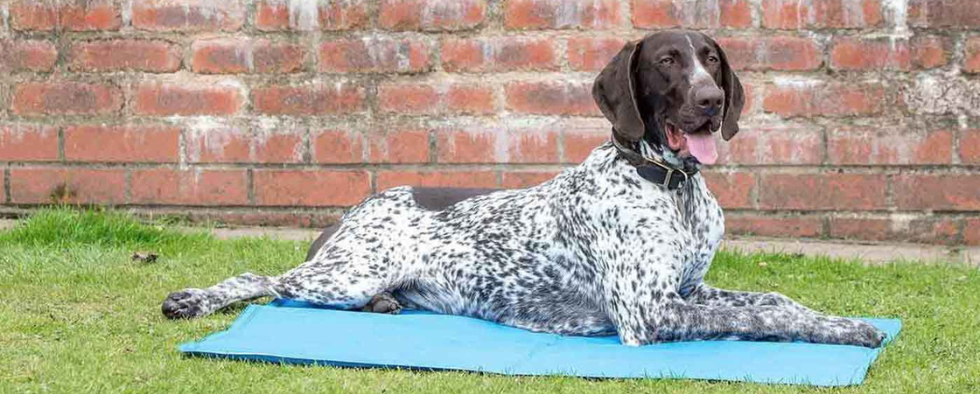Whether you’re at the beach, out exploring on a hot day, in the car, or even just relaxing at home, it’s important to look out for signs of heat stroke in dogs. This life-threatening condition is brought on by a sudden rise in body temperature and can kill dogs much faster than expected.
According to our friends at Vets Now, the UK’s leading provider of emergency pet care, spotting the signs of heat stroke early, and seeking emergency treatment, can massively increase your dog’s chance of survival. Sadly, their emergency vets see hundreds of cases of heat stroke in dogs every year and, tragically, many of these prove to be fatal.
If you do find yourself worried about heat stroke, it’s important to seek urgent medical advice. Dave Leicester, Head of Telehealth at Vets Now, reveals what to look out for.
What Causes Heat Stroke In Dogs?
There are two types of heat stroke — exertional and non-exertional. The first occurs during exercise and is much more common on hot sunny days when dogs haven’t had a chance to acclimatise to the sudden rise in heat. Dogs can take up to 60 days to acclimatise to significant changes in temperature, which isn’t ideal in the UK as the weather tends to change from week to week.

The second type is when a dog is exposed to a notable rise in temperature but doesn’t have access to the ventilation, or drinking water, to keep themselves cool. This typically occurs in a parked car, a garden with no shade, or a very hot room.
Heat Stroke Signs
In the early stages of heat stroke, your dog is likely to appear restless and distressed. They may also pant heavily and drool. As their condition worsens they will begin to lose coordination and eventually collapse. It’s worth noting that normal rectal temperature for dogs is around 38.6°C (101.5°F) to 38.9°C (102°F) and anything above this is abnormal. Other signs of heat stroke include:
- Rapid breathing
- Racing heart
- Overheating (skin hot to touch)
- Glassy eyes
- Unsteady on feet
- Vomiting
- Gums turning a bluish-purple or bright red colour
- Unconsciousness or collapse
- Seizures
If you spot any of these signs please contact your vet straight away. For out of hours, contact your nearest Vets Now pet emergency clinic or 24/7 hospital.
Diagnosis & Treatment
A vet will be in the best position to offer advice on your next steps. They may advise you to slowly cool your dog’s head and body using tepid spray before offering small amounts of water to drink. You should never immerse your dog in an ice bath or freezing cold water as cooling them too quickly can do more harm than good.
If your dog needs a physical examination, they will undergo a series of tests to determine the treatment required. If their condition is severe they will require urgent, intensive care. Your dog may be placed on a drip and given supplemental oxygen depending on whether they’re suffering breathing difficulties. Once their temperature begins to fall and their breathing is under control further diagnostic tests will be carried out.

Preventing Heat Stroke - Keep Your Dog Cool
The simplest way to ensure your dog doesn’t succumb to heat stroke is preventing it from happening in the first place. Keeping dogs cool is key. Here are some tips:
- In the summer, walk your dog early in the morning or later in the evening. Never exercise your dog in the middle of a hot day and restrict exercise on hot days
- Don’t overdo exercise during warm spells, regardless of the time of day
- Always provide a cool, shaded area for your dog to relax in
- Ensure your dog has access to plenty of fresh drinking water and always take water on a walk
- Spray your dog with cool water
- Circulate cool air on hot summer days. Open windows, turn on a box fan or keep the air conditioning on at a reasonable temperature. Your dog will appreciate having a cool place to relax indoors
- Keep dogs out of conservatories, greenhouses and stuffy rooms. These areas can get dangerously hot even when it might only feel mild outside. Bear in mind that there are no cooling breezes inside these sun traps and they magnify the heat
- Avoid long car journeys. If you decide to take your dog in the car, make sure the air conditioning is on or the windows are open. Also, take plenty of water and regular breaks for fresh air.
- Never ever leave your dog in a parked car. It can take less than 15 minutes for a dog to start overheating in a car

At Lords & Labradors we have a wide selection of cooling toys and accessories in our shop which are designed to help regulate your pup's body temperature in the Summer.
Heat stroke is a genuine medical emergency and, if you are worried about your pet, you should arrange a face-to-face examination without delay, but if you have other concerns or questions this summer, and you are unsure if your dog needs to see a vet you can get peace of mind within a few minutes with Video Vets Now. This new service by Vets Now means you can arrange a video call with one of their emergency vets within minutes, no matter where you are in the UK.
A ten-minute video consult costs £24 and is refundable if Vets Now recommend an in-person follow up within 48 hours. For more details and how to book visit: Online Vets | Video Chat With Our UK Based Vets | 8am-11pm Daily (vets-now.com)
































































































